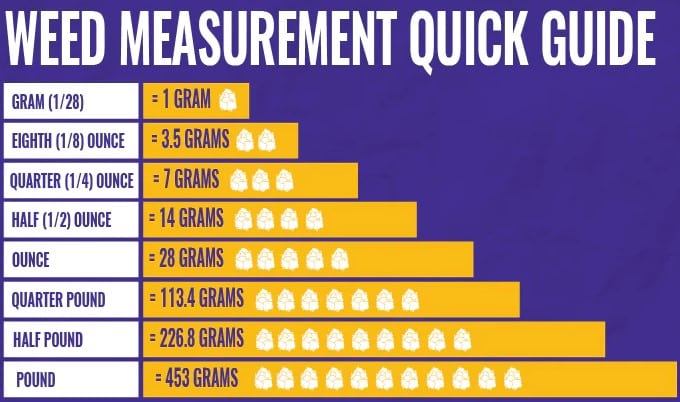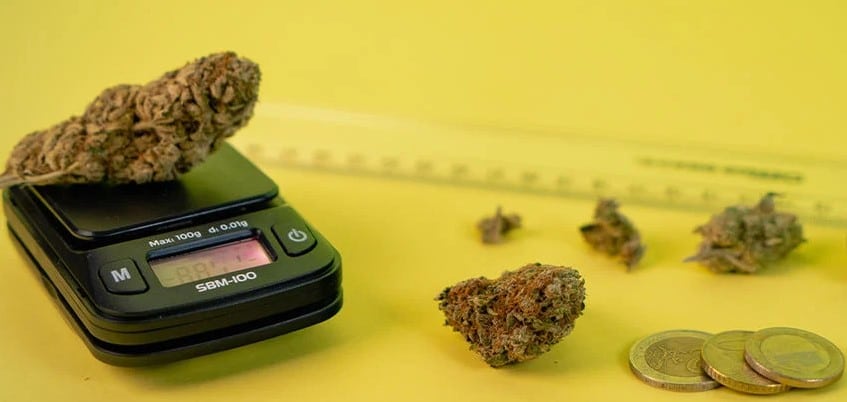Grams, ounces, “eights,” and “quarters” represent terms associated with weed measurements for cannabis, which can be perplexing for both novice and seasoned users.
The confusion arises from the alternating use of the metric and imperial systems when quantifying cannabis. For instance, when purchasing a small quantity of weed from a dispensary, you might inquire about a gram, while numerous other quantities are expressed in ounces. This discrepancy can be confounding.
Moreover, there are additional intricacies in this regard.
We aim to facilitate your comprehension of these crucial terms. To achieve this, we have compiled a comprehensive guide that elucidates imperial and metric measurements for weed, featuring accompanying visuals to provide a clear understanding of these quantities and their spatial dimensions.
Note: The terminology presented herein pertains exclusively to flowers and does not encompass edibles and concentrates.
Eighth of Cannabis
Individuals commonly reference “an eighth” or “a half quarter” when discussing cannabis quantities, prompting curiosity about the precise weight involved.
An eighth of an ounce of cannabis denotes one-eighth of an ounce, constituting a prevalent purchase among moderate cannabis users.
In metric terms, an eighth of an ounce equates to slightly over 3.5 grams.
Visually, an eighth of cannabis is approximately the size of a walnut. Depending on one’s preference, it can yield up to three blunts, three to four large joints, or around seven half-gram joints.
Interesting tidbit: An eighth of cannabis is colloquially referred to as a “slice” or a “cut” due to the common division of pizzas into eight slices.
Half-Eighth of Cannabis
The nomenclature succinctly describes this quantity—it is half of an eighth of an ounce. Visually, it resembles the size of a bean, evoking a sense of enchantment for some.
While infrequently available on the market, the term “half-eighth” persists in occasional usage.
A half-eighth of cannabis typically amounts to 1.7–1.8 grams, sufficient for crafting several medium-sized joints.
Related Article: If Amsterdam Outlaws Canna-Tourism, Where Is Europe’s New Cannabis Capital?
Quarter of Cannabis
Slang terms such as “Q,” “quad,” or simply a “quarter” pertain to a quarter of an ounce.
This equates to 7.0874 grams, commonly rounded to precisely 7 grams.
Intermediate users often opt for a “quarter,” providing a supply that may last for days or even weeks, contingent upon individual usage frequency.
With a quarter of cannabis, one can roll approximately six or seven blunts or a handful of joints.
The size of a quarter of cannabis is comparable to that of an apple.
Half of Cannabis Weed
Following the same rationale, half of cannabis denotes half an ounce of dried cannabis.
A half comprises 14.1747 grams, rounded to 14 grams.
This quantity marks a point where pricing dynamics become significant, influenced by the quality of the buds.
Visually, half of the cannabis is about the size of an orange. In culinary applications, particularly in recipes for crafting cannabutter—the foundational ingredient for various cannabis-infused edibles—this quantity is commonly stipulated.
Regular users often prefer acquiring half of an ounce to minimize the frequency of restocking their stash.
A half of cannabis is well-suited for social events, road trips, and similar activities.
One Ounce of Cannabis Weed
An ounce of cannabis precisely constitutes 28.3495 grams and is commonly retailed as 28 grams.
Frequently, enthusiasts colloquially abbreviate an ounce to simply an “O.” Additionally, it is commonly referred to as a “zip.”
It is noteworthy that the sale of such a substantial quantity of cannabis is limited, with only a few establishments offering it.
In regions south of the border, particularly in the United States, where recreational cannabis use is legal, dispensaries often present ounce deals.
Opting to purchase cannabis in whole ounces proves to be the most economically efficient method for individuals who consume it in substantial quantities daily.
The visual representation of an ounce of cannabis is comparable to the size of a coconut.

Before delving into larger quantities and subsequently transitioning back to smaller measurements denominated in grams, let us first examine this approximate visual representation of various cannabis measurements.
Quarter-Pound of Cannabis
Within the cannabis community, it is commonly referred to as a “QP,” and the nomenclature aptly describes its quantity.
A quarter-pound of cannabis is equivalent to 113.4 grams, or 4 ounces, approximately the size of four coconuts.
Half-Pound of Cannabis Weed
The primary colloquial terms for a half-pound of cannabis are “half-pack” and “half-pounder.”
A half-pound totals 226.8 grams or 8 ounces of dried cannabis. In visual terms, it may occupy as much space as half of a watermelon.
Pounds of Cannabis Weed
A pound (1 lb) translates to 448 grams, or sixteen ounces, signifying a substantial quantity. Although not as weighty as a watermelon, it occupies a comparable amount of space. Imagine such a voluminous amount of cannabis!
Frankly speaking, I find it improbable that an individual (or an entire group) could reasonably consume such a large quantity of weed within a reasonable timeframe. Therefore, I consider this volume of cannabis more appropriate for dispensary-level transactions.
It’s crucial to note that the legal limit for Weed possession and sharing in Canada is 30 grams.
One Gram of Cannabis
For those seeking smaller quantities of cannabis, opting for a gram is advisable, particularly if one is unfamiliar with the specific strain.
A gram of cannabis is commonly known as a “dime bag” due to its historical cost of around $10. It represents the smallest purchasable quantity of weed (unless one is acquiring pre-rolls, which may contain even smaller amounts).
While some dispensaries may no longer stock such diminutive amounts, they should still be reasonably accessible.
What does a gram of cannabis look like?
It is approximately the size of a hazelnut. Seasoned users with a tolerance for THC often utilize an entire gram in a single joint.
For those smoking alone, splitting it in half and rolling two smaller joints is a viable option.
When using a pipe, this amount is adequate for two or three bowls.
For individuals new to cannabis, especially if it is a high-THC indica, this quantity will undoubtedly be excessive.
Two Grams of Cannabis
Termed as a dub sack or simply a dub, this expression historically denoted cannabis priced at approximately $20, comprising a weight of two grams.
It is noteworthy that the terms “dime bag” and “dub sack” are occasionally used interchangeably in distinct regions, and these quantities do not necessarily need to precisely weigh one or two grams.
Five Grams of Cannabis
Numerous Canadian Licensed Producers (LPs) market their products in five-gram and ten-gram increments.
Five grams of cannabis equate to 0.1763 ounces. This quantity resembles the size of an egg and proves ideal for several weeks of self-medication.
Five grams would suffice for crafting four to five blunts or five to ten joints, contingent upon their dimensions.
In certain dispensaries, the expression “five-gram eighth” may be encountered. As previously mentioned, an eighth is 3.5 grams, so why the reference to five grams?
This phrase pertains to the pricing structure, signifying that a patron purchasing a five-gram eighth receives five grams for the cost of an eighth (3.5 g), presenting an advantageous deal.
Ten Grams of Cannabis
Tailored to the specific medical condition, a majority of patients opt for a 10-gram jar, utilizing it over the ensuing weeks.
While ten grams suffice for rolling numerous joints for personal and social consumption, it likely exceeds the quantity manageable for immediate consumption by a single group.
A Kilogram of Cannabis
A kilogram of cannabis represents a substantial quantity of marijuana, roughly equivalent to the size of two watermelons.
Such a substantial amount of marijuana is reminiscent of what I observed in one of the many coffee shops I frequented during my visit to Amsterdam.
To provide clarity, one kilogram equates to a thousand grams, or 2.2046 pounds.
Conversion of Grams to Ounces and Vice Versa
Navigating through various terms and measurement systems can be perplexing, yet the underlying calculations are straightforward.
Utilizing the following formula simplifies the conversion of grams to ounces: one gram equals 0.0352 ounces. Therefore, to convert any given quantity of grams to ounces, multiply it by 0.0352.
Conversely, one ounce is equivalent to 28 grams. Consequently, multiplying the number of ounces by 28 yields the precise quantity in grams.
For added convenience, a chart is provided below, eliminating the need for manual calculations:
- ⅛ of cannabis: 0.125 oz or 3.5 grams
- Half ⅛ of cannabis: 0.0625 oz or 1.75 grams
- Quarter of cannabis: 0.25 oz or 7 grams
- Half of cannabis: 0.5 oz or 14 grams
- Ounce of cannabis (oz): 28 grams
- Quarter pound of cannabis: 4 oz or 113 grams
- Half pound of cannabis: 8 oz or 226 grams
- Pound of cannabis (lb): 448 grams or 16 oz
- 1 gram: 0.035 oz
- 2 grams: 0.07 oz
- 5 grams: 0.17 oz
- 10 grams: 0.35 oz
- 1 kilogram (kg): 2.2 lbs
Understanding Weed Measurements
By comprehending the significance of various cannabis measurements, one can better grasp the legal constraints regarding the possession of cannabis in each state.
A brief note on edibles and concentrates: these products are measured differently than flowers, with the primary consideration being the amount of THC. Such quantities are typically indicated on the packaging labels, reflecting the total cannabinoid content. It is advisable to divide this total amount by the number of items or serving sizes for an accurate dosage assessment.

